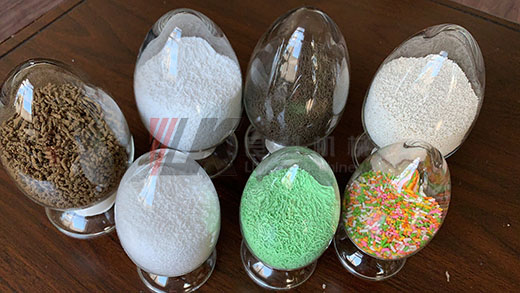Writer: admin Time:2021-01-15 10:31 Browse:℃

| Technologies / techniques | Description | Features | Advantage | Disadvantages | Equipment |
| Pneumatic dry granulation |
Dry granulation Moderate pressure and separated airflow |
High porosity, high compressibility, smell covering, quick release and better release performance | High drug loading, suitable for heat- and humidity-sensitive drugs, higher drug stability, less material consumption and waste | Repeated granulation, weak separation, poor brittleness | Roller compressor and airflow-cyclone separator or vacuum generator |
| Reverse wet granulation |
Wet granulation Water or other solvent as the granulation solution |
Granules are uniformly wetted Tablets dissolve uniformly |
Wide granule size distribution, high roundness, suitable for drugs of poor water solubility | Some large granules, low porosity, disadvantages of other granulation methods | High shear granulator |
| Steam granulation |
Wet granulation Steam as the granulation solution |
Good dispersion, uniform distribution, large surface area and good roundness | Environment-friendly, sterile and solution-free, no harmful material | Partially being over-heated or -wetted, high energy consumption, not suitable for heat-sensitive drugs, not suitable for all adhesives | High shear granulator with steam generating and controlling device |
| Moisture activation dry granulation |
Wet granulation 1-4% water as the granulating solution and moist absorbent |
Narrow size distribution, good fluidity and compressibility | Low energy consumption and no drying for the granules, wide application, continuous operation | Not suitable for water-sensitive drugs or high loaded drugs, limited proper absorbent | High shear granulator with a spraying device |
| Thermal adhesion granulation |
Wet granulation Small amount of water or solvent as the granulation solution and being heated to 30-130°C |
Good fluidity, low brittleness, and high tensile strength of tablets | High drug loading, no drying, no flying dust | High energy consumption, not suitable for heat- or humidity-sensitive drugs, not suitable for some adhesives | Mixer or similar equipment with a heating device |
| Melting granulation |
Wet granulation Meltable adhesive as granulating solution and being heated to 50-90°C |
Controllable drugs release and better dissolution | No water or solution, no drying, low energy consumption, short operation | Not proper to heat-sensitive drugs, limited proper adhesive | High shear granulator or fluid bed granulator |
| Frozen granulation |
Wet granulation Solution or suspension being sprayed, frozen and dried in vacuum |
Uniform size, good fluidity and high roundness | Uniform granule, controllable granule density, less material loss, suitable for drugs which are not sensible to heat | Limited proper solvent, only suitable for solution or suspension granulation | Spraying frozen and drying granulator |
| Foam granulation |
Wet granulation Foam as the granulation solution |
Uniform distribution of adhesive, preventing granules from excessively wetted and large foam surface area | No spraying, small amount of water, short granulation time and suitable for water-sensitive drugs | Not suitable for water-sensitive drugs, limited proper adhesive | High shear granulator or fluid bed grnulator with foam generator |
Tel: +86 731 84325468
Phone: +86 13787413551
Email: ava@lkpharmamachinery.com
Whatsapp: +86 13787413551(Ms. Ava)
Add: Ruian city, Zhejiang province